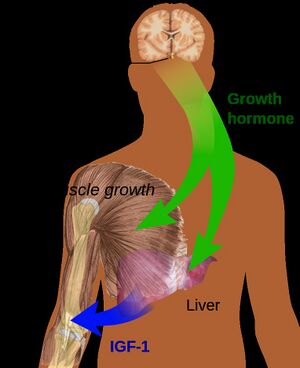Growth Hormone
Original Editor - Lucinda hampton
Top Contributors - Lucinda hampton and Vidya Acharya
Introduction[edit | edit source]
Human growth hormone (HGH), also known as somatotropin, is a 191 amino acid single-chain polypeptide. It is produced by somatotropic cells within the anterior pituitary gland.[1]
HGH is secreted in a pulsatory way, generally following a circadian rhythm. Various physiological stimuli can cause HGH secretion, the most influential, non-pharmacological being sleep and exercise.
HGH has numerous roles throughout life, from growth itself, including the turnover of muscle, bone and collagen, to the regulation of particular aspects of metabolic function for example increased fat metabolism and the maintenance of a healthier body composition in later life.[2]
IGF-1 is a hormone that manages the effects of HGH in the body. Together, IGF-1 and GH promote normal growth of bones and tissues.[3]
Sub Heading 2[edit | edit source]
Sub Heading 3[edit | edit source]
Resources[edit | edit source]
- bulleted list
- x
or
- numbered list
- x
References[edit | edit source]
- ↑ Brinkman JE, Tariq MA, Leavitt L, Sharma S. Physiology, Growth Hormone. InStatPearls [Internet] 2020 May 16. StatPearls Publishing. Available:https://www.ncbi.nlm.nih.gov/books/NBK482141/ (accessed 16.8.2022)
- ↑ Godfrey RJ, Madgwick Z, Whyte GP. The exercise-induced growth hormone response in athletes. Sports medicine. 2003 Jul;33(8):599-613. Available:https://pubmed.ncbi.nlm.nih.gov/12797841/ (accessed 16.8.2022)
- ↑ Medline plus IGF 1 Test Available:https://medlineplus.gov/lab-tests/igf-1-insulin-like-growth-factor-1-test/ (accessed 16.8.2022)







